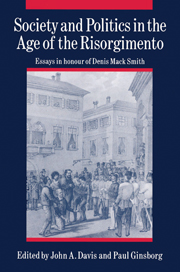Book contents
- Frontmatter
- Contents
- List of figures and maps
- List of contributors
- Preface
- Map 1 Italy in 1815
- Map 2 Italy in 1870
- Map 3 Italy – place names
- 1 1799: the Santafede and the crisis of the ancien régime in southern Italy
- 2 War and society in Napoleonic Italy: the armies of the Kingdom of Italy at home and abroad
- 3 The poor and how to relieve them: the Restoration debate on poverty in Italy and Europe
- 4 Bandits, violence and the organization of power in Sicily in the early nineteenth century
- 5 Marriage and the family in Italy in the early nineteenth century
- 6 After the Revolution: bandits on the plains of the Po 1848–54
- 7 Labouring women in northern and central Italy in the nineteenth century
- 8 Garibaldi in England: the politics of Italian enthusiasm
- 9 The middle classes in Liberal Italy
- 10 Francesco De Sanctis: the politics of a literary critic
- Bibliography of Denis Mack Smith's writings on nineteenth-century Italy
- Index
1 - 1799: the Santafede and the crisis of the ancien régime in southern Italy
Published online by Cambridge University Press: 30 January 2010
- Frontmatter
- Contents
- List of figures and maps
- List of contributors
- Preface
- Map 1 Italy in 1815
- Map 2 Italy in 1870
- Map 3 Italy – place names
- 1 1799: the Santafede and the crisis of the ancien régime in southern Italy
- 2 War and society in Napoleonic Italy: the armies of the Kingdom of Italy at home and abroad
- 3 The poor and how to relieve them: the Restoration debate on poverty in Italy and Europe
- 4 Bandits, violence and the organization of power in Sicily in the early nineteenth century
- 5 Marriage and the family in Italy in the early nineteenth century
- 6 After the Revolution: bandits on the plains of the Po 1848–54
- 7 Labouring women in northern and central Italy in the nineteenth century
- 8 Garibaldi in England: the politics of Italian enthusiasm
- 9 The middle classes in Liberal Italy
- 10 Francesco De Sanctis: the politics of a literary critic
- Bibliography of Denis Mack Smith's writings on nineteenth-century Italy
- Index
Summary
In the spring and summer of 1799 the Italian peninsula seemed to become the promised land of the counter-revolution. When the armies of the French Directory were defeated in the Po valley in April, the recently founded Italian Republics were at once thrown into crisis and popular counter-revolutionary risings erupted virtually throughout the length of Italy. In Tuscany, the peasants of Arezzo rallied to the banners of the Blessed Virgin and to chants of Viva Maria! marched to destroy the Jacobins in Florence and Siena. In Lombardy, Viora Branda dreamed that he had been summoned by Christ to punish the infidel invaders; calling themselves the Massa Cristiana he and his peasant followers joined the Austrians to drive the French and the Jacobins out of Piedmont. In many parts of central Italy, in Lazio, in Umbria, and in the Marche, similar popular risings took place.
Yet nowhere was the scale or violence of the counter-revolution greater than in the south. Here the Neapolitan Republic had only been established in January 1799. In the previous autumn the king of Naples, Ferdinand IV, had launched an ill-judged offensive against the French forces occupying Rome. But the offensive was a disaster. The Neapolitan army was routed and in January 1799 Ferdinand and Maria Carolina abandoned their capital and fled on Nelson's warships to Palermo. The French armies swept south and, as they drew closer, tensions and fears of betrayal provoked a violent anti-republican rising in Naples.
- Type
- Chapter
- Information
- Society and Politics in the Age of the RisorgimentoEssays in Honour of Denis Mack Smith, pp. 1 - 25Publisher: Cambridge University PressPrint publication year: 1991
- 2
- Cited by



